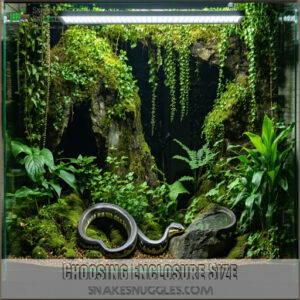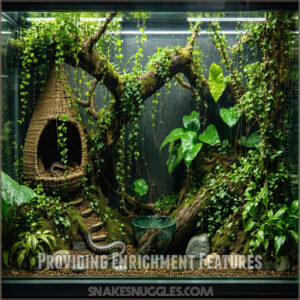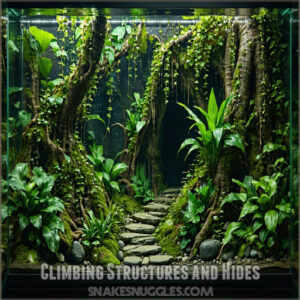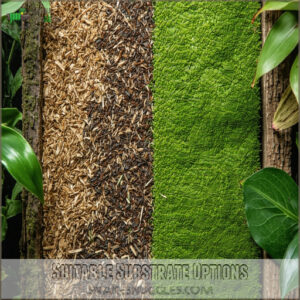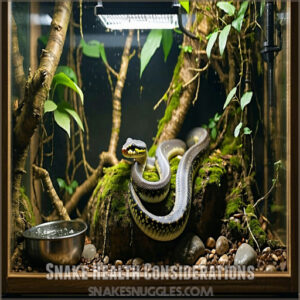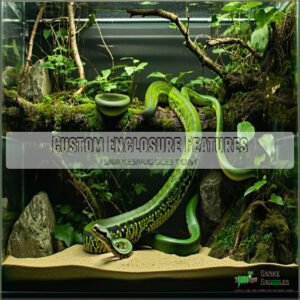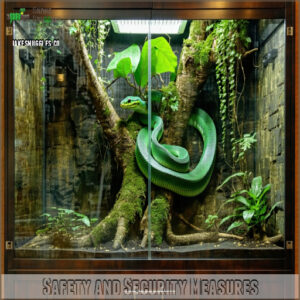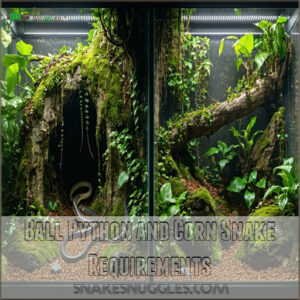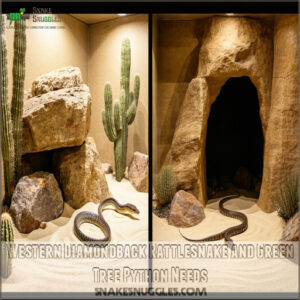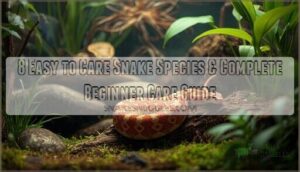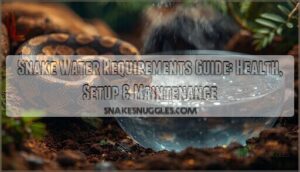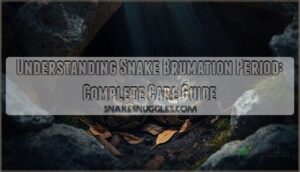This site is supported by our readers. We may earn a commission, at no cost to you, if you purchase through links.
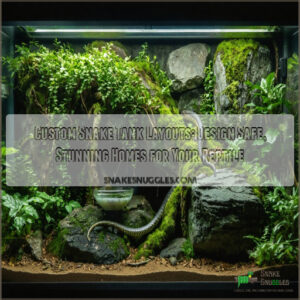 When creating custom snake tank layouts, think of it as designing your snake’s dream home.
When creating custom snake tank layouts, think of it as designing your snake’s dream home.
Start with the right enclosure size—1.5 times the snake’s length is a solid rule of thumb.
Add secure hides for cozy naps, climbing structures for the adventurers, and a substrate that matches your snake’s natural habitat.
Corn snakes love airy setups, while ball pythons prefer snug, warm spaces.
Don’t forget enrichment—plants, rocks, or even a faux desert vibe can make it pop!
Plus, proper heating and ventilation keep your snake comfy and healthy.
Ready to level up?
Tiny details can make a world of difference.
Table Of Contents
- Key Takeaways
- Choosing Enclosure Size
- Enclosure Design Features
- Snake Health Considerations
- Custom Enclosure Features
- Safety and Security Measures
- Species-Specific Layouts
- Frequently Asked Questions (FAQs)
- Should you build a custom snake enclosure?
- How do I build my own snake cage?
- How can I make a snake tank look authentic?
- How do I customize my PVC snake cage?
- How do I choose a snake enclosure?
- How do you make a snake enclosure?
- How do I design for limited room space?
- What materials reduce enclosure weight for portability?
- Can I integrate automation for feeding schedules?
- How can I childproof a snake tank setup?
- Conclusion
Key Takeaways
- Measure your snake’s length and plan a tank that’s at least 1.5 times that size to ensure enough space for movement and growth.
- Add secure hides, climbing structures, and an appropriate substrate to mimic your snake’s natural habitat and keep it engaged.
- Prioritize safety with escape-proof locks, ventilated lids, and materials that prevent accidental escapes or injuries.
- Choose proper heating and humidity control, and lighting to match your snake’s species-specific needs for a healthy, stress-free environment.
Choosing Enclosure Size
Getting the right enclosure size for your snake isn’t just about comfort; it’s key to keeping them healthy and stress-free.
Choose a tank that’s at least 1.5 times the length of your snake, with enough space for movement and growth.
Measuring Snake Length
Snake length guidelines start with nailing the measurement.
Grab a flexible ruler or a soft tape—trust me, it’s way easier than wrestling a yardstick!
Follow this 3-step trick:
- Stretch it straight along the snake’s relaxed body.
- Measure gently, no squeezing; snakes hate that.
- Double-check the full length for accurate sizing in custom snake enclosures.
Accounting for Growth Space
You’ve measured your snake, but don’t forget to think ahead!
Account for its growth rate to avoid constant tank upgrades.
Aim for an enclosure 1.5x your adult snake’s length.
This guarantees proper space allocation for movement and prevents overcrowding.
To confirm the best fit, consider using a ball python enclosure size calculator for precise measurements.
| Snake Size (Adult) | Min Tank Length | Ideal Width | Recommended Height |
|---|---|---|---|
| 2-3 ft | 3.5 ft | 12-18 in | 12-24 in |
| 4-5 ft | 6-7 ft | 16-20 in | 18-24 in |
| 6-7 ft | 9-10 ft | 20-24 in | 24-36 in |
| 8+ ft | 12+ ft | 24-30 in | 36+ in |
Strategize tank expansion for future custom snake enclosures.
Future proofing your snake tank designs?
Smart move!
Selecting Optimal Tank Dimensions
Sizing your tank right saves headaches later.
A good rule? Length of the enclosure = 1.5 times your snake’s length.
Upgrading often is no fun, so plan ahead.
- Use flexible tape for accuracy.
- Add width for movement and growing room.
- Create space for hides and climbing.
- Opt for seamless, escape-proof materials.
- Prioritize practical snake tank designs!
Enclosure Design Features
Designing a snake enclosure is all about combining safety with creativity to meet your pet’s needs.
Add features like hides, climbing spots, and the right substrate to create a space that’s both functional and visually appealing.
Providing Enrichment Features
Adding enrichment features jazzes up your snake’s environment and keeps them engaged.
Rotate enrichment toys or decor for sensory stimulation.
Try puzzle feeders or dig boxes to encourage exploration.
A variety of hideouts and climbing walls build a dynamic snake environment setup.
Providing environmental enrichment is essential for promoting natural behaviors in snakes.
| Enrichment Item | Purpose | Example Ideas |
|---|---|---|
| Snake Hideouts | Privacy and security | Coconut huts, caves |
| Enrichment Toys | Mental stimulation | Puzzle feeders, tubes |
| Climbing Walls | Exercise and enrichment | Branches, ladders |
Climbing Structures and Hides
Speaking of enrichment features, let’s talk climbing and hiding!
Your snake loves exploring, so trick out its tank with:
- Tree branches and climbing walls for exercise.
- Cozy rock caves to snooze undisturbed.
- Flexible hide boxes for privacy.
- Fun snake tunnels for lurking and adventure.
These snake cage designs keep your reptile happy while turning custom snake tanks into natural wonderlands!
Suitable Substrate Options
The right substrate makes or breaks your snake’s comfort.
Choose based on humidity control, shedding ease, and cleaning.
For smooth decision-making, check this table of substrate options:
| Substrate Materials | Benefits | Drawbacks |
|---|---|---|
| Aspen Shavings | Odor control, absorbent | Can mold if too moist |
| Coconut Husk | Great for moisture levels | Needs frequent changes |
| Reptile Carpet | Reusable, easy to clean | Limited digging appeal |
Understanding reptile substrate options is essential for creating a suitable environment.
Perfect substrate selection = happier snake!
Snake Health Considerations
Keeping your snake healthy starts with creating the right environment that meets its specific needs.
From preventing respiratory issues to promoting smooth shedding, the details of your tank setup can make all the difference, including addressing issues like preventing respiratory problems to ensure your snake stays healthy in its right environment.
Common Health Issues in Snakes
Snake health demands attention, with respiratory diseases, skin infections, and feeding disorders being common but preventable with proper care.
Here’s how to stay ahead:
- Monitor temperature gradients for respiratory problems.
- Maintain humidity for easy shedding.
- Support parasite control with regular checks.
- Watch for stubborn feeding issues.
- Support bioactive setups for balanced environments.
Regular veterinary care and checking for snake health problems can help identify issues early on, ensuring a healthy, thriving snake.
Keep an eye on these to guarantee a healthy, thriving snake, and remember that proper care is key to preventing common issues like respiratory problems.
Recognizing Signs of Illness
Spotting illness early means paying close attention.
Is your snake refusing food? Any wheezing, swollen scales, or lethargy? These could be illness warning signs.
Regular snake behavior analysis helps: sluggish movement, irregular shedding, or odd posture can hint at issues.
Keep health monitoring tools handy, and don’t hesitate—veterinary care options can address snake disease diagnosis promptly, keeping them thriving.
Preventing Respiratory Problems
Poor air quality can wreck your snake’s health, leading to respiratory problems and stress.
Tackle this with proper humidity control—50-70% works for most snakes—and reliable ventilation systems.
A balanced temperature gradient (85-90°F warm, 75-80°F cool) keeps breathing difficulties at bay, and daily tweaks to your setup show you care, ensuring ideal snake health with minimal fuss, through proper humidity control and a balanced temperature gradient.
Promoting Healthy Shedding
In terms of shedding cycles, your snake’s tank layout plays a big role.
Keep humidity control in check—use a hygrometer to stay at 50-70%, or a bit higher for specific species.
Add coarse materials like branches for rubbing off old skin, and ensure balanced temperature gradients also support skin health.
Always monitor moulting processes to guarantee smooth shedding and happy reptile care.
Custom Enclosure Features
You can transform your snake’s enclosure with custom features that balance functionality and style.
From stackable designs to realistic backgrounds and precise heating solutions, these upgrades create a secure, stunning habitat your reptile will thrive in, with custom features.
Rabbeted and Recessed Frames
Building custom snake tanks? Rabbeted and recessed frames are your MVPs for structural integrity and style.
They make assembly a snap while boosting frame durability.
- Choose sturdy frame materials like PVC or hardwood.
- Verify snug fits for gap-free snake tank designs.
- Reinforce joints for strength—no snake escapes here!
Simple, secure, and escape-proof!
Stackable Design and Modular Options
Stackable designs are a game-changer for custom snake tanks.
Modular options let you create a sleek, multi-level setup, perfect for maximizing vertical space in compact systems.
These expandable designs are durable and easy to clean, making them a hit for busy reptile keepers.
Whether housing one snake or many, stackable enclosures make snake tank layouts flexible and efficient, which is a key aspect of a sleek, multi-level setup.
Backgrounds, Rocks, and Plants
Let’s make your snake’s space more like the wild outdoors. Adding background designs, rock formations, and live plants brings life and personality to the tank.
Use decorative stones and nontoxic plants to create stunning natural aesthetics. Consider a snake tank background to enhance the overall visual appeal of the enclosure.
- Choose 3D background decor for depth.
- Place sturdy rocks for climbing spots.
- Add nontoxic plants for greenery.
- Use live plants for humidity boosts.
- Arrange decorative stones for texture.
Heating Solutions and Thermostat Regulation
To keep your snake comfy, mastering temperature control is non-negotiable.
Pairing heat sources like lamps, pads, and ceramic emitters with proper thermostat settings creates stable temperature gradients.
Check out this quick guide:
| Heating Solution | Best For | Placement |
|---|---|---|
| Heat Lamp | Warmth above ground | Over basking spot |
| Heat Pad | Belly heat | Under tank |
| Radiant Heat Panel | Large enclosures | Side or ceiling of the tank |
Proper climate management prevents overheating disasters.
Understanding snake enclosure heating systems is essential for creating a safe and healthy environment for your pet snake.
Safety and Security Measures
Keeping your snake safe starts with a secure lid, escape-proof locks, and sturdy materials that block even the sneakiest attempts at freedom.
Don’t forget to snake-proof cords and check ventilation holes—they should be smaller than your snake’s head to avoid any unexpected Houdini moments!
Secure Lid and Escape-Proof Locks
In the context of escape-proofing, a secure lid is your frontline defender.
Snakes are escape artists, so focus on safety features like these:
- Locking Mechanisms: Tight-locking lids keep even the sneakiest snakes inside.
- Secure Fasteners: Use clamps or latches for peace of mind.
- Lid Designs: Think mesh tops with no gaps or tough sliding panels.
Smart snake tank ideas start here!
Double-Door Entry System
A double-door entry system is a game-changer in custom snake tanks.
Think of it as your safety net for handling and feeding.
This design reduces escape risks while offering controlled access to secure lids and door mechanisms.
For maximum security, explore various snake cage security essentials.
Snake tank designs with this feature prioritize escape prevention and simplify maintenance, making them a top choice for custom reptile enclosures and thoughtful snake enclosure ideas.
Ventilation Hole Size and Electrical Cord Protection
In custom snake tanks, ventilation systems and cord safety are non-negotiable.
Vent holes need to be smaller than your snake’s head—prevention beats panic regarding snake escapes.
For cords, protect them like treasure.
- Use PVC conduit for electrical protection.
- Keep holes snug yet breathable.
- Strategically place vents for air quality.
- Block curious snakes from wires.
- Think escape-proof snake tank designs, considering cord safety as a priority.
Species-Specific Layouts
Creating the perfect tank means understanding your snake’s unique needs—it’s not a one-size-fits-all deal.
From cozy hides for Ball Pythons to high perches for Green Tree Pythons, tailoring the setup to match their natural behavior keeps them happy and healthy.
Ball Python and Corn Snake Requirements
Ball pythons thrive in cozy, secure enclosures with warm and cool hideouts to match their behavior.
Use a 40-gallon tank for adults, ensuring temperature gradients fit their environmental needs.
Corn snakes need snake tank designs with locked lids, proper ventilation, and space for movement.
Both benefit from easy-to-clean substrates and custom snake tanks designed to mimic natural habitats.
Western Diamondback Rattlesnake and Green Tree Python Needs
Western diamondback rattlesnakes thrive in a Rattlesnake Habitat that mimics a Desert Climate.
Think sturdy, sandy substrates, rocks, and secure hides.
Green tree pythons, with their striking colors, need Tropical Environments—branches for climbing and basking, plus humidity control for a cozy Snake Behavior fit.
Custom snake tank layouts blend these needs into specialized reptile tank setups, keeping them safe and stress-free.
Nocturnal Snake Lighting and Behavioral Adaptations
When it’s lights out, managing nocturnal activity patterns in nocturnal snakes is key.
Create shadow-rich spaces and use gentle moonlight simulation for Nighttime observation.
Dark cycle management supports natural snake behavior while hiding spots keep them cozy and calm.
Combine subtle lighting with steady temperature gradients to mimic their environment, ensuring a stress-free and enriching nocturnal habitat.
Mirroring Ecological Niches and Natural Habitats
Bringing your snake’s world into their tank isn’t just cool—it’s how you make them thrive. Think about Habitat Replication like this:
- Add realistic terrain modeling (rocks, cork bark) for Environmental Enrichment.
- Use plants or bioactive setups to mimic ecosystem balance. Consider species-specific needs when creating a natural snake habitat.
- Integrate Natural Lighting to reflect day-night patterns.
These snake habitat ideas make custom snake terrariums truly special!
Frequently Asked Questions (FAQs)
Should you build a custom snake enclosure?
Imagine cleaning up endless escapes because your store-bought tank’s too small.
Building a custom snake enclosure gives you control to create a secure and stylish habitat, avoiding costly upgrades and giving your snake room to thrive.
How do I build my own snake cage?
Start by measuring your snake’s full adult size to plan the cage dimensions.
Use durable materials like PVC or glass, include proper ventilation, secure locks, and temperature zones.
Add hides, climbing spots, and substrate for comfort.
How can I make a snake tank look authentic?
Ever notice how nature beats any decoration?
Use real substrate, driftwood, and climbing features like branches.
Add rocks, live plants, and a background with natural scenery.
Keep it cozy, like their wild home, but secure!
How do I customize my PVC snake cage?
Deck out your PVC snake cage with sliding panels for easy access, built-in side vents for airflow, and snug hides.
Add climbing branches, textured backgrounds, and digital thermostats to keep your snake cozy and stress-free.
How do I choose a snake enclosure?
Picking a snake enclosure is like choosing a new apartment—size, security, and comfort matter most.
Verify it’s escape-proof, fits your snake’s adult length, offers proper temperature gradients, and includes hiding spots for privacy.
How do you make a snake enclosure?
Measure your snake’s adult size, choose escape-proof materials like PVC or glass, and add vents for airflow.
Include hideouts, climbing features, and a sturdy water dish.
Focus on temperature gradients and secure locks.
How do I design for limited room space?
Did you know snakes can escape through gaps smaller than a pencil?
For tight spaces, go vertical with stackable, modular designs.
Include climbing features, use compact lighting, and maximize corners for hides and decorations.
What materials reduce enclosure weight for portability?
Lighten your load with materials like PVC panels, acrylic sheets, or ABS plastic.
They’re sturdy, easy to clean, and won’t break your back when moving the tank.
Bonus: they resist moisture and look sleek!
Can I integrate automation for feeding schedules?
Imagine never missing a feeding—you can automate it.
Use programmable feeding devices for live or pre-packaged meals.
Pair it with smart timers and cameras to monitor everything, giving you peace of mind and hands-free efficiency.
How can I childproof a snake tank setup?
Secure the tank with escape-proof locks and a sturdy lid.
Cover vents with mesh small enough to block curious fingers.
Hide cords, avoid sharp edges, and keep the tank on stable, out-of-reach surfaces.
Childproof complete!
Conclusion
Designing custom snake tank layouts is like crafting the ultimate VIP suite for your scaly friend.
With the right size, secure hides, climbing features, and a substrate that mimics their natural home, you create a space that’s both cozy and exciting.
Don’t skimp on safety—escape-proof locks and proper ventilation are non-negotiable.
By tailoring the tank to your snake’s needs, you’re not just building a habitat; you’re making their world thrive.
Let creativity and care lead the way!
- https://www.customcages.com/custom-snake-cages.html
- https://snakesnuggles.com/snake-tank-setup-guide/
- https://www.zenhabitats.com/blogs/reptile-care-sheets-resources/basics-of-providing-enrichment-for-snakes
- https://aquaworldhub.com/how-to-keep-humidity-in-snake-tank/
- https://www.myfamilyvets.co.uk/snake-health-problems

